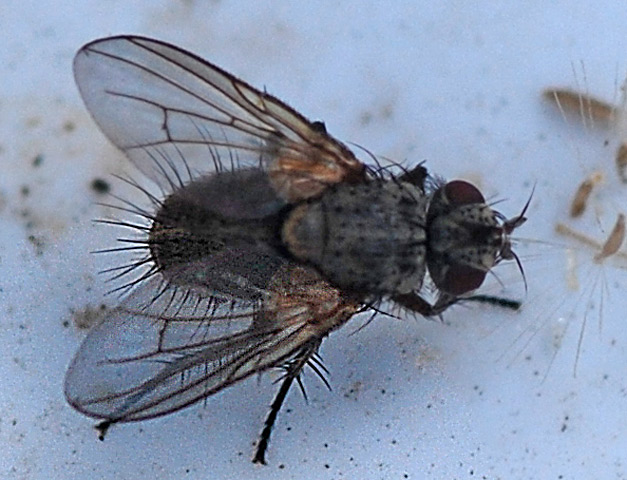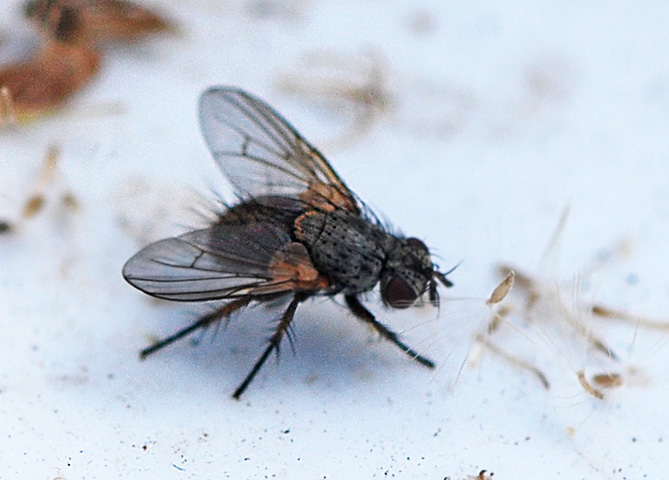Diptera.info :: Identification queries :: Diptera (adults)
|
Tachinidae - cf. Goniini sp./Blondeliini sp.
|
|
| Walther Gritsch |
Posted on 16-10-2010 12:03
|
|
Member Location: Copenhagen Posts: 290 Joined: 31.01.09 |
Hi On the danish nature site wildaboutdenmark.com this small Tachinid has appeared. It was shot 12. X 2010 by Finn Krone. The fly was beaten out of low vegetation in a coastal habitat on the island Sjaelland. The fly was not collected. It looks Siphonini-ish. The scutellar apicals are weak and the subapicals are converging. It lacks the bend in vein M ľ all of which makes me think of Actia lamia. But A. lamia has only one ad on t2, this fly has three. Another option would be Ocytata pallipes, I guess, but with converging subapicals... couldn't be. I am even beginning to suspect the lacking bend in M is an aberration. Looks kind of weird. Body length less than 5 mm in my estimation (no size given). Is it possible to name the species? Regards, Walther Gritsch attached the following image:  [97.9Kb] Edited by Walther Gritsch on 19-10-2010 12:11 Walther |
|
|
|
| Walther Gritsch |
Posted on 16-10-2010 12:04
|
|
Member Location: Copenhagen Posts: 290 Joined: 31.01.09 |
Dorsal
Walther Gritsch attached the following image:  [96.87Kb] Walther |
|
|
|
| Walther Gritsch |
Posted on 16-10-2010 12:05
|
|
Member Location: Copenhagen Posts: 290 Joined: 31.01.09 |
Dorsolateral
Walther Gritsch attached the following image:  [96.53Kb] Walther |
|
|
|
| ChrisR |
Posted on 16-10-2010 13:11
|
|
Super Administrator Location: Reading, England Posts: 7706 Joined: 12.07.04 |
Something like Phytomyptera perhaps? The broken median vein does look like an aberration but in some Phytomyptera that section is sometimes weak and indistinct.
Manager of the UK Species Inventory in the Angela Marmont Centre for UK Biodiversity at the Natural History Museum, London. |
| Walther Gritsch |
Posted on 16-10-2010 18:57
|
|
Member Location: Copenhagen Posts: 290 Joined: 31.01.09 |
Yes, perhaps but in that case it must be from that part of Phytomyptera that originally was called Elfia. Those I have no experience with. Phytomyptera nigrina I know and it is quite different. Regards, Walther |
|
|
|
| Zeegers |
Posted on 18-10-2010 20:19
|
|
Member Location: Soest, NL Posts: 19213 Joined: 21.07.04 |
Pity the fly was not collected. The lacking topvein is clearly aberrant, you can see still some part of it at its apex. Phytomyptera are all very blackish (in Europe), and Actia it cannot be for the reaons given above. Looks more like some Goniini or possibly Blondeliini. In any case, missing topcel is likely to be aberrant. It is weird, but it happens. Theo |
|
|
|
| Walther Gritsch |
Posted on 19-10-2010 12:10
|
|
Member Location: Copenhagen Posts: 290 Joined: 31.01.09 |
I dare say it's a pity it wasn't collected. If it had been it would have been in my collection by now! You say Goniini (or Blondeliini). I thought that converging subapicals were restricted to Siphonini, but that is evidently not the case. Just a stray thought... What about Goniocera sp.? Regards, Walther |
|
|
|
| Zeegers |
Posted on 19-10-2010 18:41
|
|
Member Location: Soest, NL Posts: 19213 Joined: 21.07.04 |
Good point. I missed the converging subapicals. They are not restricted to Siphonini, but indeed uncommon elsewhere. The third antennal segment is definitely too long for Goniocera, moreover, Goniocera are strictly spring species. Theo |
|
|
|
| Walther Gritsch |
Posted on 10-11-2011 20:25
|
|
Member Location: Copenhagen Posts: 290 Joined: 31.01.09 |
It's a long time since we abandoned this. In the meantime the interactive key of Moschweb has come and I thought it would be interesting to test it on this tachinid. If I select only the characteristics in the pictures I am certain about, I arrive at Bithia sp. and given the place and perhaps time of year a possibility might be Bithia geniculata - a very rare species... Now the question is whether this is a sound choice? I have never seen the species, but perhaps someone else has. Moschweb is really a fantastic tool if you work with photo-ID'ing tachinids, but is this a bridge too far? 
Walther |
|
|
|
| sd |
Posted on 10-11-2011 22:09
|
|
Member Location: Suffolk, UK Posts: 892 Joined: 11.10.07 |
I agree - Moschweb is great both for photos and pinned specimens Steve |
|
|
|
| ChrisR |
Posted on 11-11-2011 00:23
|
|
Super Administrator Location: Reading, England Posts: 7706 Joined: 12.07.04 |
Hmm, it just doesn't look very Bithia-ish to me ... it does still look very siphonine to me though. To be siphonine you need converging subapicals AND hairs along r4+5 most of the way to rm or beyond, I think. But I can't convince myself that I can see the wing hairs ... but it looks very Actia-ish. Definitely "one that got away"! 
Manager of the UK Species Inventory in the Angela Marmont Centre for UK Biodiversity at the Natural History Museum, London. |
| Jump to Forum: |













